Orthodoxy and the Early Church
1st century ‘Truths’ defined by 2nd century bishops
“Orthodoxy” (orthodoxeia) is not a word to be found in scripture. Rather, it originated with the organization of the Catholic Church. Thus, the 4th century propagandist of the True Faith, St. Augustine, pronounced that:
“True Religion is to be sought .. among those alone who are called Catholic Christians, or the orthodox, that is, the custodians of sound doctrine and followers of right teaching.”
– Augustine, De Vera Religione, 391.
For three centuries a bewildering plethora of Christian cults had vied with each other and their pagan adversaries. Eventually, at a time of acute political crisis, one particular faction insinuated itself into the political establishment. With real power within its grasp, it stressed not universal love but disciplined obedience of Church leaders and a conformity of thought.
Dogmas and creeds, learned by rote, displaced speculations on the divine. This sterile “sound doctrine” rejected and condemned the more esoteric notions advanced by rival factions and wild notions of egalitarianism, poverty and common property.
Orthodoxy and its Critics
“The enmity of the Christians towards each other surpassed the fury of savage beasts against man.”
– Ammianus Marcellinus, 4th century Roman historian.
Search in vain for orthodoxy in the 1st or 2nd centuries. “Apostolic teaching” is a fantasy invented by the Church. The “early Fathers” were bitter rivals, protagonists in a struggle between fiercely competitive groups and schools of thought.
It was only three centuries after the supposed “facts” of JC’s life and teachings that rancorous assemblies of ambitious and fanatical clerics decided what precisely was that life and teaching.
The distinction between orthodoxy and its opponents was never as clear cut as later ‘official’ Church historians were to maintain. Many so-called Gnostics had held positions of authority within the early Church, as did the Apologists later stigmatised as heterodox and heretical. Orthodoxy even appears to have had its own factions. The synoptic “12 Apostles and a ministry of 12 months” has a hint of gnosticism about it, connecting the superstar with the zodiac and astrology. A rival faction of the orthodox favoured a much longer ministry for their hero and a rebuttal of the more esoteric gnostic doctrines. Their ideas entered the canon in the Gospel of John.
Orthodoxy favoured a set of simplistic tales, little more than “comings and goings” of the godman, comprehensible to the uneducated, and readily re-enacted in pageant and ceremonial. These fables were held to be “true accounts from recent history”.
In a series of councils and assemblies spanning two centuries, an officially approved and obligatory dogma was hammered out which was then stamped upon the credulous mind of humanity. Those with the temerity to question the creed and sacraments were criminalized, persecuted and eliminated.
Invention of Orthodoxy
Ignatius? (60-115?)
Epistles attributed to Ignatius make the earliest references to events which feature ‘Jesus of Nazareth.’
Ignatius was the first to name “Mary” and use the term “Catholic”. He attacked both the Judaisers and the Docetists.
But many of the epistles are certainly later forgeries – and they probably all are.


Irenaeus? (125-202?)
Heresy hunting bishop of Lyons, Irenaeus was the main promulgator of the cult of the “Virgin Mary”.
This pillar of early orthodoxy had some pretty unorthodox views of his own.
He dates the crucifixion of JC in the late 1st century when his hero is an old man!
Cyprian? (200-258?)
A wealthy orator and legal advocate before his mid-life conversion, Cyprian rapidly established himself as bishop of Carthage and the boss of north African Christianity.
A fierce advocate of the Church hierarchy, Cyprian achieved a rare distinction in the early church: he actually was executed in 258, as “ringleader of an unlawful association.”

The 2nd century literature of gnostic “romances” had proved immensely popular. Those close to the growing Church hierarchy plagiarised and edited these texts, purging them as best they could of gnostic esoterics and adding in the one message truly their own: obedience of the bishops
Paul’s epistles had been compromised by 1st century Jewish Gnosticism. But in the mid-2nd century Marcion had appended them to his own (the original) gospel and were too widely known to be suppressed.
The answer was new letters by “Paul”, the so-called Pastoral Epistles, universally acknowledged to be spurious. The fake epistles use the device of “Timothy” and “Titus”, companions of Paul, to instruct the brethren in how they were to organize the local Churches. They are, it seems, sent as bishops to Ephesus and to Crete where they exercise authority over both clergy and laity, guard “the purity of the Church’s faith”, and ordain priests.
Unlike the original Pauline epistles the Pastorals exclude all reference to “spiritual gifts” (the tool of the apocalyptic sects) and concentrate instead on establishing a hierarchy of cadres.
“I left thee in Crete, that thou shouldest … ordain priests in every city …”
– Titus, 1. 5,7
For the first time there is mention of bishops and presbyters holding positions of power (the word bishop itself appears to have been borrowed from the civic administration of Syria, the “episcopi”). Charisma is now conferred by a solemn laying on of hands:
“Wherefore I put thee in remembrance that thou stir up the gift of God, which is in thee by the putting on of my hands.”
– 2 Timothy 1.6.
Ignatius – Bishop with Attitude, First Voice of Orthodoxy
The Pastorals provided “scripture” which established divine approval of episcopal authority. The falsehood had now to be constructed that none less than the Apostles themselves had established that very hierarchy which led, in an unbroken line, to the entrenched authorities of the Catholic Church in Rome. For this the Epistles of St. Ignatius served the purpose.
In official “Catholic history” Ignatius bears witness to the beliefs and organization of the early Christian church (which, of course, turns out to be all very Catholic and orthodox). And yet the unconvincing “celebrity tour and insistent martyrdom” of Ignatius conceals a more mundane reality: almost certainly Ignatius was an inconsequential Christian zealot from Syria who got himself executed in Rome.
Half a century later, one (or several) eminent churchmen of Asia Minor used the dead fanatic as a prop for a series of letters bringing church organizations and wayward priests into the subordination of bishops. Ignatius himself is made a disciple of the Apostles. The fabrications also present an opportunity to colour in more details of the Jesus fantasy and to fix the godman himself in an historical past.
“Ignatius started that process … building up a dramatic story of Jesus’ life … making use both of his authority as a bishop and would-be martyr, and also of previous writers’ efforts to extract information from what they considered to be references to the Messiah in the Old Testament.”
– Ellegard, Jesus -100 years before Christ, p206-6.
The authors of “Ignatius”, probably using a copy of Josephus as their source, chose the rule of the most infamous of Roman prefects, Pontius Pilate, as the time-frame for his godman’s sojourn on earth. Joy of joy, Josephus provides so many telling details from the period, including the deaths of many rebels. Indeed, there is scarcely a name, or an incident, in the entire New Testament which is not presaged in the works of Josephus
Again and again Ignatius asserts that the supremacy of the bishop is a divine institution. He goes so far as to affirm that the bishop stands in the place of Christ Himself!
“When ye are obedient to the bishop as to Jesus Christ it is evident to me that ye are living not after men, but after Jesus Christ … Be ye obedient also to the presbytery as to the Apostles of Jesus Christ.”
– ad Trallians, 2.
In a breathtaking assertion at (supposedly) so early a date Ignatius tells us that bishops are to be found even in “the farthest parts of the earth” (ad Ephes.3) The next act in the coup will be the elevation of St Peter – supreme pastor of the Church, resident of Rome, and bishop of the whole Church!
These examples of mid-2nd century fraud were followed by others: “letters by Ignatius” were still being written into the 5th century!
Irenaeus –
“A 10+ year Ministry for Jesus, who Lived into Old Age!”
This hero of Catholic orthodoxy made his reputation by castigating numerous 2nd century heresies which he called “diseases of the human mind”. Heresy hunting became his life’s work.
Irenaeus attacked the “licentious practices” and “foolish doctrines” of the heretics – spread, it seems, by the aid of “silly women”.
But Irenaeus was not above a bit of Jesus fictionalising himself:
“The Thirty aeons are not typified by the fact that Christ was baptized in his 30th year: He did NOT suffer in the twelfth month after his baptism, but was MORE THAN FIFTY YEARS OLD WHEN HE DIED.”
– Against Heresies, II, 22.
Irenaeus tells us that Jesus’s public ministry continued at least 10 years, and that JC was seen alive in Asia, with his disciple John and others, up to the time of the Emperor Trajan
“From the 40th and 50th year a man begins to decline towards old age, which our Lord possessed while He still fulfilled the office of a Teacher, even as the Gospel and all the elders testify; those who were conversant in Asia with John, the disciple of the Lord, affirming that John conveyed to them that information. And he remained among them up to the times of Trajan.”
Trajan’s reign began in 98 AD, by which time Jesus would have already been just over 100 years old! Thus according to the venerated saint, Jesus was crucified as a very old man! Some variants of the story even suggest an age of 120!
Storyteller Irenaeus was probably the author of the lurid account of the “sufferings martyrs” in his home city of Lyons.
What better method to drum up sympathetic support than a bogus tale of heroics?
Cyprian
Styled a “champion of Church unity” Cyprian coined the phrase:
“No one can have God as Father who does not have the Church as mother.”
– De Catholicae Ecclesiae Unitate.
For all that, Cyprian spent almost his whole time as bishop embroiled in Church politics. Initially a student of the severe Tertullian, Cyprian clashed with “anti-pope” Novatian over the re-admittance of the lapsi and with Pope Stephen II for rejecting baptisms performed by heretics and apostates.
Epiphanius of Salamis
“Jesus Born about 100 BC”
For nearly forty years Epiphanius exerted his authoritarian influence across the eastern Mediterranean. From his see of Constantia (Salamis) on the island of Cyprus this senior bishop’s distaste for the “poisons of heresy” and lust for power drove him to intervene in Antioch (against the Apollinarians, who said Jesus had no human soul once Christ had entered him); against Origenism in Jerusalem, with its allegorical interpretations of biblical events, and against Arianism everywhere. In fact, this notorious heresy hunter identified no fewer than 80 exotic and prosaic heresies, the remedy for which he set out in his “Medicine chest” (“Panarion”).
Epiphanius, of course, knew the “Truth” – which for him meant Jesus was born during the reign of the Hasmonean king Alexander Jannaeus, who ruled Judaea between 103-76 BC.
“For with the advent of the Christ, the succession of the princes from Judah, who reigned until the Christ Himself, ceased.
The order failed and stopped at the time when He was born in Bethlehem of Judaea, in the days of Alexander, who was of high-priestly and royal race …
And this Alexander, one of the anointed and ruling princes placed the crown on his own head …
– Epiphanius (Haer., 29.3)
Perhaps Jesus was born twice, with a century in between his visitations?
With the death of Alexander, power passed to his wife, Salome and when she died, a struggle for succession broke out between Jannaeus’s two sons, John Hyrcanus II and Aristobulus II. In 63 BC Roman general Pompey arrived and confirmed Hyrcanus as high priest (63-40 BC) but real power passed to Antipater and Herod as client kings of Rome.

Epiphanius? (?310-403)
4th century Christian Bishop of Salamis and heresy hunter:
The A B C of Literalist Fraud
“No Proof Needed – Miracles the Only Evidence.”
“ For there is no need, to persons of intelligence, to attempt to prove, from the deeds of Christ subsequent to his baptism, that his soul and his body, his human nature like ours, were real, and no phantom of the imagination.
For the deeds done by Christ after his baptism, and especially his miracles, gave indication and assurance to the world of the Deity hidden in his flesh.”
– Bishop Melito of Sardis (died 177).
Tellingly, when early Christian Apologists struggled to prove the “truth” of their beliefs they turned, not to contemporary evidence of Jesus’ existence – which surely they would have done if they could! – but to the prophets and psalms of the Old Testament.
They cut verses out of context and altered them to make them appear to be speaking about Jesus. Later, with the ‘Sayings tradition’ taken from the Gnostics, pious fraudsters set the words into the vignettes plagiarized from the Old Testament. The multitude of micro-stories were then strung together in a meandering itinerary.
The result was the Gospels, not historical documents, but catechisms, written for the sole purpose of inculcating faith.
Only in a later age, when the Church had assumed the mantle of absolute power, would the Empty Tomb, the True Cross, the Apostles’ bones and the rest of the paraphernalia of fraudulent “evidence” appear.
The Closed Mind, the Prison of Orthodoxy
A pure and uncorrupted “orthodoxy” never existed, nor did it, with the Lord’s guiding hand, convince the foolish of their errors by contending with wilful and perverse heresy. “Orthodoxy” eventually emerged from a plethora of competitive sects after a considerable and prolonged struggle.
The story of the godman, never more than a disjointed pageant of heroic failure, ignominious death and an unfathomable godly rebirth, became the almost empty canvass upon which “schismatics, heretics, and apostates” painted a rich and variegated dreamscape of human suffering, sorrow and hope.
Orthodoxy took time to get its act together, taking what it could use from the very sources it would later condemn. At first, only slowly did it marginalise and eliminate its critics. But the pace quickened once what became orthodoxy was empowered as the State/Church religion.
Orthodoxy took time to get its act together, taking what it could use from the very sources it would later condemn. At first, only slowly did it marginalise and eliminate its critics. But the pace quickened once what became orthodoxy was empowered as the State/Church religion.
Guided from the throne room and the palace, orthodoxy would fashion itself to the needs of the caesars, confirming it’s role as the faith of empire, a Universal and Catholic faith. In the end only a narrow dogma remained, chanted and learned by rote.
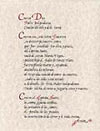
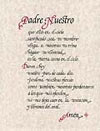
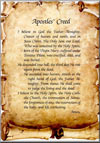
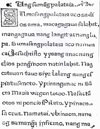
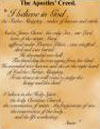
Creeds – Pre-packed thinking
Nicene creed
“We believe in one God, the Father, the Almighty maker of heaven and earth, of all that is, seen and unseen. We believe in one Lord, Jesus Christ, the only Son of God, eternally begotten of the Father, God from God, Light from Light, true God from true God, begotten, not made, of one Being with the Father. Through him all things were made. For us and for our salvation, he came down from heaven: by the power of the Holy Spirit he became incarnate from the Virgin Mary, and was made man. For our sake he was crucified under Pontius Pilate; he suffered death and was buried. On the third day he rose again in accordance with the Scriptures; he ascended into heaven and is seated at the right hand of the Father. He will come again in glory to judge the living and the dead, and his kingdom will have no end. We believe in the Holy Spirit, the Lord, the giver of Life, who proceeds from the Father and the Son. With the Father and the Son he is worshipped and glorified. He has spoken through the Prophets. We believe in one holy catholic and apostolic Church. We acknowledge one baptism for the forgiveness of sins. We look for the resurrection of the dead, and the life of the world to come.”
Now that settles things so no more questions!
Sources:
- Maxwell Staniforth, Early Christian Writings (Penguin, 1978)
- L. Boyle, St. Clements, Rome (Collegio San Clemente, 1989)
- Jean Ritchie, The Secret World of Cults (Harper Collins, 1991)
- John Riches, The World of Jesus (Cambridge University Press, 1990)
- Nicholas Carter, The Christ Myth (HRP, 1993)
- Thomas Sheehan, The First Coming (Crucible, 1986)
- Michael Walsh, Roots of Christianity (Grafton, 1986)
- Peter Roberts, In Search of Early Christian Unity (Vantage, 1985)
Related Articles:
What DID the Early Christians Believe?
Bizarre Beginnings – Assortment of Early Christian Belief
Nice Gnostics – Christian ‘Mystics of Knowledge’
Making an Apology – Christian writers of the 2nd century
The Syncretic Heritage of Christianity
Circus, Circus! – ‘Apologetics’ – Fundamentally Flawed
Christianity’s Fabrication Factory


Between the 2nd and 4th centuries the fable of Jesus was not even agreed by Christian bishops!
“Jesus still alive in the reign of Trajan” – said 2nd century bishop Irenaeus. [Trajan 98-117 AD]
“Jesus born before Herod the Great” – said 4th century bishop Epiphanius. [Herod 73-4 BC]
Acceptance of an historical Jesus by Christian communities, many of which had been established by the Gnostics, progressed slowly and erratically.
In different Christian communities different beliefs about Christ opposed and overlapped each other for many centuries.
At the forefront of rendering gnostic allegory into fake history was the Church of Rome.
Eventually the approved story would be hammered out at rancorous Church councils and codified into creeds to be learned by rote.
T & T
Timothy is said to have been a teenage assistant to Paul hired in Galatia. He seems to have had no say when his boss decided to circumcise him! (Acts 16.3)
His reports from Thessalonica. led to 1 Thessalonians.
The fanciful Acts of Timothy record the young hero’s martyrdom (stoned and clubbed) by dastardly pagans at the Dionysian festival of Katagogia.
Titus was said to have been a Greek companion of Paul, sent as his representative to Corinth and taking 2 Corinthians with him. He was subsequently made “first bishop” to Crete.
His head – well, someone’s head – turned up in 9th century Venice.
End to Free Speech?
“But avoid foolish questions, and genealogies, and contentions, and strivings about the law; for they are unprofitable and vain.
A man that is an heretick after the first and second admonition reject;
Knowing that he that is such is subverted, and sinneth, being condemned of himself.”
– Titus, 3.9,11.
Manicheans – "The Spirit Can't be Trapped."
The Manicheans, inspired by the 3rd century Persian mystic Mani (216-277), accepted Jesus as a spiritual leader but held to the gnostic idea that all matter was evil, trapping the divine spirit.
For them, the Christ could never have entered a human body. If he had done so he would have lost his power (a bit like Kryptonite proving fatal to Superman).
In other words, for these exotic Christians, Jesus and Christ were quite separate entities.
Mani himself was an early-day Muhammad, claiming he had received the ‘final, universal revelation’ and making his first converts within his family.
The cult spread from Persia to Syria, Palestine, India, and across north Africa, where it claimed its most famous convert (Saint) Augustine.
Manichaeism continued at least until the 7th century.
Arianism – "Jesus Neither God nor Man"
The movement led by the Alexandrian presbyter Arius (256-336) led to two centuries of internecine strife over the “true nature of the Lord.”
Arius’s Platonic logic convinced him (and many others, including the emperor Constantine) that Jesus was “similar to an angel, not human, but not quite God.”
As ever, theological wrangling and power politics resolved the issue – not any recourse to historical fact.
Docetists – "Apparition of a man"
The Catholic Church, striving to eradicate their Gnostics rivals, coined the term “Docetists” (from the Greek “to seem”) to describe those heretics who believed their Christ’s divinity was irreconcilable with his taking human form.
A faint echo of this ancient skirmish is to be found in the First Epistle of John, a multi-author work put together by the orthodox:
“Many false prophets are gone out into the world. Hereby know ye the Spirit of God: every spirit that confesseth that Jesus Christ is come in the flesh is of God.
And every spirit that confesseth not that Jesus Christ is come in the flesh is not of God:
And this is that spirit of antichrist, whereof ye have heard that it should come; and even now already is it in the world.”
– 1 John 4.1,3

Why would this epistle need denounce the deniers of a human Jesus other than because many Christians did, indeed, deny a human "Jesus of Nazareth."
Jerome?
(340-420)
Expert linguist, Jerome was hired by the gangster pope Damasus to re-write the Bible.
His version, the “Vulgate”, became the official edition up to the Renaissance.
Jerome also wrote a useful compilation of biographies De viris illustribus (On famous men).
Augustine? (354-430)
Superstar of the Latin Fathers, Augustine of Hippo wrote the “CIty of God” to absolve Christians from any blame for the fall of Rome.
He gave the Church much of its inhumanity and ruthlessness, with concepts of “original sin” and the use of force.
He also contributed the novel idea that Christianity pre-dates Christ!
“What we now call the Christian religion existed amongst the ancients, and was from the beginning of the human race, until Christ Himself came in the flesh; from which time the already existing true religion began to be styled Christian”.
– St. Augustine (Retract., I, xiii, 3)


Lorem ipsum dolor sit amet, consectetur adipiscing elit. Ut elit tellus, luctus nec ullamcorper mattis, pulvinar dapibus leo.